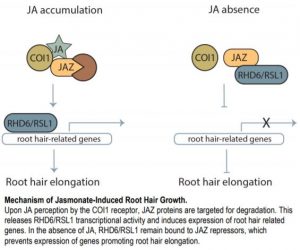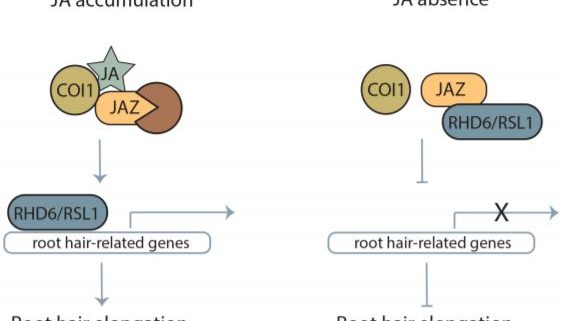Hormonal Solution for (Root) Hair Extension
Root hairs are tubular outgrowths of a subset of root epidermal cells serving multiple roles, including plant anchorage in the soil, water and nutrient absorption, and symbiotic interactions with nitrogen fixing bacteria in legumes (Salazar-Henao et al., 2016). Root hairs form an interface between the plant and the environment, therefore their development is tightly regulated by external cues. For example, in plants suffering from phosphate or iron deficiency, enhanced root hair growth contributes to increased root surface area and facilitates nutrient uptake. Several genes governing root hair growth are also induced by hormone signaling (Salazar-Henao et al., 2016). While in some species (for example tomato) every epidermal cell can form a root hair, in Arabidopsis hair cells alternate with non-hair cells (Dolan and Costa, 2001). Acquisition of hair cell identity requires a suite of transcription factors, whereas elongation of a root hair is induced by two transcription factors, RHD6 (ROOT HAIR DEFECTIVE6) and RSL1 (RHD6 LIKE 1) (Salazar-Henao et al., 2016).
In recent work, Han et al. (2020) provide a mechanistic description of jasmonate‑induced root hair growth. The authors show that exogenous application of jasmonate (JA) promotes elongation of root hairs via enhanced expression of RHD6, RSL1, and their transcriptional targets. Disruptions in the core JA signaling pathway resulted in altered root hair elongation. Mutants in COI1 (CORONATINE-INSENSITIVE1), the JA receptor and a positive regulator of JA signaling, had shorter root hairs, whereas simultaneous disruption of five JAZ (JASMONATE ZIM-DOMAIN), co-receptors acting as JA repressors, promoted root hair elongation. Overexpression of RHD6 restored root hair elongation in JA insensitive mutants, indicating that RHD6 functions downstream of JA perception machinery (Han et al., 2020).
 JA responses are mediated by the interaction of JAZ proteins with several transcription factors. Han et al. (2020) showed that five JAZ proteins physically interacted with RHD6 and RSL1, which inhibited transcriptional activity of the latter. In the proposed model, JA binds to the coreceptor COI1 and targets JAZ proteins for proteasomal degradation. This releases RDH6/RSL1 from JAZ repressors, enabling their transcriptional activity and subsequent root hair elongation. In the absence of JA, the JAZ proteins are stabilized, thus their interaction with RHD6/RSL1 is enhanced. RHD6/RSL1 trapped in the complex with JAZ proteins are unable to bind to their target gene promoters and induce root hair elongation.
JA responses are mediated by the interaction of JAZ proteins with several transcription factors. Han et al. (2020) showed that five JAZ proteins physically interacted with RHD6 and RSL1, which inhibited transcriptional activity of the latter. In the proposed model, JA binds to the coreceptor COI1 and targets JAZ proteins for proteasomal degradation. This releases RDH6/RSL1 from JAZ repressors, enabling their transcriptional activity and subsequent root hair elongation. In the absence of JA, the JAZ proteins are stabilized, thus their interaction with RHD6/RSL1 is enhanced. RHD6/RSL1 trapped in the complex with JAZ proteins are unable to bind to their target gene promoters and induce root hair elongation.
Interestingly, JA also inhibits main root growth via another target of JAZ proteins, the transcription factor MYC2. MYC2 represses the expression of PLT1 (PLETORA1) and PLT2, which are key regulators of root stem cell niche maintenance (Chen et al., 2011). Thus, JA functions in the root in a cell type-specific manner. In meristematic cells JA acts as a growth repressor (Chen et al., 2011), while in epidermal cells JA enforces root hair growth (Han et al, 2020). Regulation of these two processes relies on JAZ‑dependent repression of different transcription factors.
JA is a hormone induced by pathogen attack, wounding and several abiotic stresses (Howe et al., 2018). It is easy to imagine that the growing root is exposed to mechanical stress resulting from soil penetration, as well as myriad biotic interactions, all of which can induce JA accumulation. Ceasing root growth would decrease its surface area, which might be compensated for with the enhanced root hair elongation. Root hair elongation engages only epidermal cells, while root growth requires integration of programs of multiple cell types. Thus, enhancing root hair elongation can facilitate nutrient acquisition with minimal energy cost.
The work of Han et al. (2020) provides a better understanding of how JA signaling is integrated with developmental programs. Importantly, it also presents JA as a hormone with versatile roles, including acting in a cell type-specific manner.
Dorota Kawa, University of California, Davis
ORCID: 0000-0002-4227-1621
REFERENCES
Chen Q, Sun J, Zhai Q, Zhou W, Qi L, Xu L, Wang B, Chen R, Jiang H, Qi J, Li X, Palme K, Li C (2011) The basic helix-loop-helix transcription factor MYC2 directly represses PLETHORA expression during jasmonate-mediated modulation of the root stem cell niche in Arabidopsis. Plant Cell 23: 3335-3352
Dolan L, Costa S (2001) Evolution and genetics of root hair stripes in the root epidermis. J Exp Bot 52: 413-417
Han X, Zhang M, Yang M, Hu Y (2020) Arabidopsis JAZ Proteins Directly Interact with and Suppress RHD6 Transcription Factor to Regulate Jasmonate-Stimulated Root Hair Development. The Plant Cell https://doi.org/10.1105/tpc.19.00617
Howe GA, Major IT, Koo AJ (2018) Modularity in Jasmonate Signaling for Multistress Resilience. Annu Rev Plant Biol 69: 387-415
Salazar-Henao JE, Velez-Bermudez IC, Schmidt W (2016) The regulation and plasticity of root hair patterning and morphogenesis. Development 143: 1848-1858




